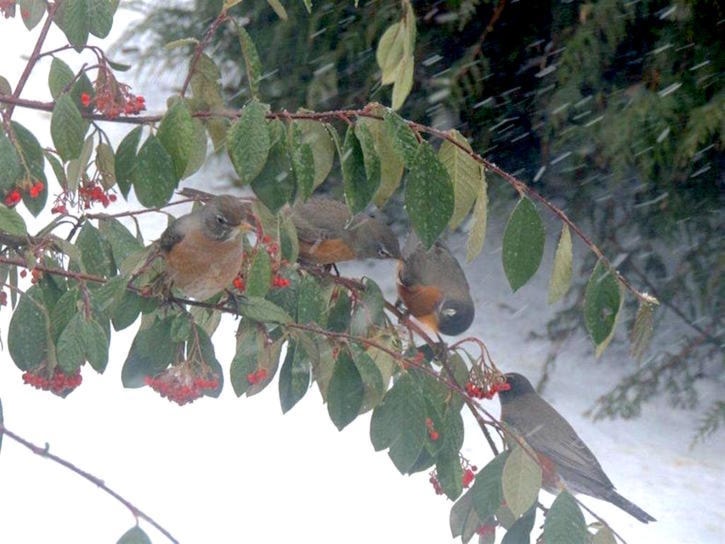The sun shines brightly again. Birds are singing and spring arrived on March 21.That doesn’t mean a thing of course. The weather is as chilly as ever and things are slow. The ton of snow cleared out all our cotoneaster berries last week, or should I say, the robins did. They were hungry as wolf-hounds and ate up every last berry, even the ones that fell to earth.
The bush has risen since it lost the weight of berries, birds and snow. It was a true phenomenon to see up to 70 robins feeding like crazy for three days. The lone Cedar Waxwing didn’t seem to stand a chance — every time it came in to feed it was chased off. So it moved to another bush as yet undiscovered by the hungry horde.
Fortunately, the rains came just in time to keep the birds from starving for lack of sustenance. Now all the robins are out in the meadow, finding what they really need. The thrush family eats mostly invertebrates and insects, and soil wrigglers are their preferred snack. They like soft soil so they can get at them, so another place they feed is the intertidal zone, especially the Delkatla Wildlife Sanctuary. If it wasn’t for the ocean, this would be a dead zone. The sea is the great provider.
Sadly, the ocean is becoming a sea of dirt and new studies indicate that microfibres, tiny threads shed from fabric, have been found in abundance on shorelines where wastewater is released. Even our clothes are unsafe. Researchers at the University of California at Santa Barbara found that on average, synthetic fleece jackets release 1.7 grams of microfibres each wash. The study also found older jackets shed almost twice as many fibres as new ones. Patagonia, the outdoor clothing manufacturer, funded the study, so things might change. But it’s never too late for us to change the clothes we wear. More info on these fibres can be found at www.theguardian.com.
The doves are cooing. They are the latest introduced species to invade the islands and are joining starlings as the new nuisance bird. We don’t know how they got here and whoever brought them isn’t saying, but chicks will be on the way soon. Speaking of, the Killdeer are now on the nest. All four eggs have been laid and are being kept warm by mama and papa. There’s lots of territorial shenanigans going on: one bird chases another, it’s chased back, another joins the fray, then everything goes quiet.
Killdeer are a noisy bird, but pretty, with two black necklaces on their white front. They have a bright rusty-red tail to display when any threats are near. It pretends to be injured, the predator chases the red flash with a meal in mind, then off flies the Killdeer healthy as anything, and the nest is safe.
Green-winged Teal still huddle along the water’s edge. Their numbers are down, some may already have ventured out towards their nesting grounds further north, but most are staying until the interior warms up and their natal ponds thaw out. A Fox Sparrow sang on March 15, the first of the year.
